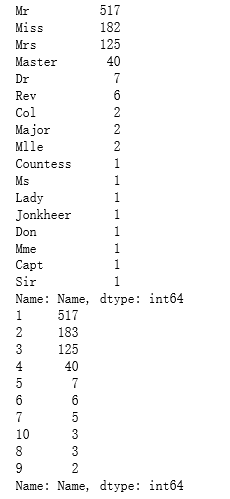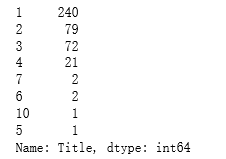基于已有的信息预测当遇难时,是否可以获救
第一步,提取出最有价值的信息
survived→0表示遇难,1表示幸存
Pclass→舱室类型
Name→遇难者姓名
Sex→性别
Age→年龄
SibSp→有多少亲人一起来坐船
Parch→身边有多少老人和孩子
Ticket→票的编号
Fare→票价
Cabin→舱号
Eabarked→在不同的站区上的车
第二步,制作出分类器完成预测是否可以获救
(一)导入数据
import pandas
titanic = pandas.read_csv("titanic_train.csv") #导入数据
titanic.head(5) #打印出前5行数据观察

(二)缺失值的填充
titanic["Age"] = titanic["Age"].fillna(titanic["Age"].median()) #用均值对“Age”特征的缺失值进行填充
print titanic.describe() #打印出各特征的属性

(三)对于字符量将其映射成数值的量
①转换“Sex”列
print titanic["Sex"].unique() #打印出“Sex”特征组中的所有可能性
titanic.loc[titanic["Sex"] == "male", "Sex"] = 0
titanic.loc[titanic["Sex"] == "female", "Sex"] = 1
输出[‘male’ ‘female’]
②转换“Eabrked”列
print titanic["Embarked"].unique()
titanic["Embarked"] = titanic["Embarked"].fillna('S') #对非连续的值进行填充,谁多用谁填充
titanic.loc[titanic["Embarked"] == "S", "Embarked"] = 0
titanic.loc[titanic["Embarked"] == "C", "Embarked"] = 1
titanic.loc[titanic["Embarked"] == "Q", "Embarked"] = 2
输出[‘S’ ‘C’ ‘Q’ nan]
nan表示的有缺失值
观察数据,谁最多用谁填充
(四)应用机器学习算法来实现分类
Ⅰ在训练集中预处理与操作
①通过线性回归
#导入线性回归
from sklearn.linear_model import LinearRegression
#Sklearn还具有一个帮助程序,可以轻松进行交叉验证
from sklearn.cross_validation import KFold
#我们用来预测目标的列(特征)
predictors = ["Pclass", "Sex", "Age", "SibSp", "Parch", "Fare", "Embarked"]
#初始化我们的算法类
alg = LinearRegression()
#为泰坦尼克号数据集生成交叉验证折叠。它返回与训练和测试对应的行索引。
#我们设置随机状态以确保每次运行此操作时得到相同的拆分。
kf = KFold(titanic.shape[0], n_folds=3, random_state=1)
predictions = []
for train, test in kf:
# 我们正在使用的预测变量训练算法。 注意我们如何在训练集中取行。
train_predictors = (titanic[predictors].iloc[train,:]) #把train的数据拿到手
#我们用来训练算法的目标。
train_target = titanic["Survived"].iloc[train] #把训练的标签拿到手
# 利用预测器和目标对算法进行训练。
alg.fit(train_predictors, train_target)
#我们现在可以在测试中做出预测了
test_predictions = alg.predict(titanic[predictors].iloc[test,:])
predictions.append(test_predictions)
通过线性回归得到的结果进行比较,若<0.5未获救,>.5的则获救
import numpy as np
#这些预测是在三个独立的numpy数组中进行的。将它们连接成一个。
#我们将它们连接在轴0上,因为它们只有一个轴。
predictions = np.concatenate(predictions, axis=0)
#将预测映射到结果(只有可能的结果是1和0)
predictions[predictions > .5] = 1
predictions[predictions <=.5] = 0
accuracy = sum(predictions[predictions == titanic["Survived"]]) / len(predictions) #预测的和真实给定的label进行比较
print accuracy #打印出准确率
输出 0.783389450056
②通过逻辑回归
from sklearn import cross_validation
from sklearn.linear_model import LogisticRegression
#初始化我们的算法
alg = LogisticRegression(random_state=1)
#计算所有交叉验证折叠的准确度得分。(比以前简单多了!)
scores = cross_validation.cross_val_score(alg, titanic[predictors], titanic["Survived"], cv=3)
#取分数的平均数(因为我们每叠有一个)
print(scores.mean())
输出 0.787878787879
Ⅱ在测试集中进行预处理与操作
titanic_test = pandas.read_csv("test.csv")
titanic_test["Age"] = titanic_test["Age"].fillna(titanic["Age"].median())
titanic_test["Fare"] = titanic_test["Fare"].fillna(titanic_test["Fare"].median())
titanic_test.loc[titanic_test["Sex"] == "male", "Sex"] = 0
titanic_test.loc[titanic_test["Sex"] == "female", "Sex"] = 1
titanic_test["Embarked"] = titanic_test["Embarked"].fillna("S")
titanic_test.loc[titanic_test["Embarked"] == "S", "Embarked"] = 0
titanic_test.loc[titanic_test["Embarked"] == "C", "Embarked"] = 1
titanic_test.loc[titanic_test["Embarked"] == "Q", "Embarked"] = 2
(五)使用随机森林分类器改进模型
①建立随机森林模型
from sklearn import cross_validation
from sklearn.ensemble import RandomForestClassifier
predictors = ["Pclass", "Sex", "Age", "SibSp", "Parch", "Fare", "Embarked"]
#用默认参数初始化我们的算法
#n_estimators 是我们要造的树的数目
#min_samples_split 是进行拆分所需的最小行数
#min_samples_leaf 是在树枝结束的地方(树的底部)我们可以拥有的最小样本数。
alg = RandomForestClassifier(random_state=1, n_estimators=10, min_samples_split=2, min_samples_leaf=1)
#计算所有交叉验证折叠的准确度得分。(比以前简单多了!)
kf = cross_validation.KFold(titanic.shape[0], n_folds=3, random_state=1)
scores = cross_validation.cross_val_score(alg, titanic[predictors], titanic["Survived"], cv=kf)
#取分数的平均数(因为我们每叠有一个)
print(scores.mean())
输出为 0.785634118967
②发现其输出与回归模型相似,调整随机森林的参数(很花时间)
alg = RandomForestClassifier(random_state=1, n_estimators=100, min_samples_split=4, min_samples_leaf=2)
#计算所有交叉验证折叠的准确度得分。(比以前简单多了!)
kf = cross_validation.KFold(titanic.shape[0], 3, random_state=1)
scores = cross_validation.cross_val_score(alg, titanic[predictors], titanic["Survived"], cv=kf)
#取分数的平均数(因为我们每叠有一个)
print(scores.mean())
输出 0.814814814815
③难以通过参数选择提升精度时,额外再提取一些特征让分类器去学习(增加一些新的特征)
#生成一个新的"familysize"特征,把所有家庭成员加到一起,有可能家庭成员的数量对逃生有一定影响
titanic["FamilySize"] = titanic["SibSp"] + titanic["Parch"]
#假设名字的长度和获救有关
titanic["NameLength"] = titanic["Name"].apply(lambda x: len(x))
#提取名字的称谓特征,假设称谓的不同对是否获救也有关联
import re
#从名称中获取标题的函数。
def get_title(name):
#使用正则表达式搜索标题。标题总是由大写和小写字母组成,并以句号结尾。
title_search = re.search(' ([A-Za-z]+)\.', name)
#如果标题存在,则提取并返回它。
if title_search:
return title_search.group(1)
return " "
#获取所有标题并打印每个标题出现的频率。
titles = titanic["Name"].apply(get_title)
print(pandas.value_counts(titles))
#将每个标题映射为整数。有些标题非常罕见,并且被压缩成与其他标题相同的代码。
title_mapping = {"Mr": 1, "Miss": 2, "Mrs": 3, "Master": 4, "Dr": 5, "Rev": 6, "Major": 7, "Col": 7, "Mlle": 8, "Mme": 8, "Don": 9, "Lady": 10, "Countess": 10, "Jonkheer": 10, "Sir": 9, "Capt": 7, "Ms": 2}
for k,v in title_mapping.items():
titles[titles == k] = v
#确认我们转换了所有内容。
print(pandas.value_counts(titles))
#在“标题”列中添加。
titanic["Title"] = titles

④增加了一部分后,对这些特征进行衡量选出最有价值的特征
验证方法:建立随机森林模型后会得到一个错误率erroB1,若想知道其中一个特征有多大的重要性,把这个特征的列完全破坏掉后得到的错误率erroB2,观察这两次准确率的差值,若相差不多,则说明这一列特征不重要
用feature_selection这个库,选择哪个特征是最重要的
import numpy as np
from sklearn.feature_selection import SelectKBest, f_classif
import matplotlib.pyplot as plt
predictors = ["Pclass", "Sex", "Age", "SibSp", "Parch", "Fare", "Embarked", "FamilySize", "Title", "NameLength"] #候选特征
#对特征进行选择
selector = SelectKBest(f_classif, k=5)
selector.fit(titanic[predictors], titanic["Survived"]) #通过“Survived”这个Label去衡量每一个特征的重要性
#之后两部分就是画图流程
#获取每个特征的原始p值,并从p值转换为分数
scores = -np.log10(selector.pvalues_)
#画出分数。看看“阶级”、“性别”、“头衔”和“费用”哪一个最好的?
plt.bar(range(len(predictors)), scores)
plt.xticks(range(len(predictors)), predictors, rotation='vertical')
plt.show()
#只选择四个最好的特征。
predictors = ["Pclass", "Sex", "Fare", "Title"]
alg = RandomForestClassifier(random_state=1, n_estimators=50, min_samples_split=8, min_samples_leaf=4)
**从图中可以剔除对是否获救影响不重要的特征

(六)用集成的方法来做
from sklearn.ensemble import GradientBoostingClassifier
import numpy as np
#我们要集成的算法。
#我们对logistic回归使用了更多的线性预测,所有的都使用了梯度增强分类器。
algorithms = [
[GradientBoostingClassifier(random_state=1, n_estimators=25, max_depth=3), ["Pclass", "Sex", "Age", "Fare", "Embarked", "FamilySize", "Title",]],
[LogisticRegression(random_state=1), ["Pclass", "Sex", "Fare", "FamilySize", "Title", "Age", "Embarked"]]
] #将两个算法集成在一起
#初始化交叉验证折叠
kf = KFold(titanic.shape[0], n_folds=3, random_state=1)
predictions = []
for train, test in kf:
train_target = titanic["Survived"].iloc[train]
full_test_predictions = []
#对每个折叠上的每个算法进行预测
for alg, predictors in algorithms:
#在训练数据上拟合算法。
alg.fit(titanic[predictors].iloc[train,:], train_target)
#选择并预测测试折叠。
#.astype(float)是将数据帧转换为所有float并避免sklearn错误所必需的。
test_predictions = alg.predict_proba(titanic[predictors].iloc[test,:].astype(float))[:,1]
full_test_predictions.append(test_predictions)
#使用一个简单的加密方案——只需平均预测就可以得到最终的分类。
test_predictions = (full_test_predictions[0] + full_test_predictions[1]) / 2 #把两次预测的结果加在一起除二求平均值
#任何大于.5的值都假定为1预测,小于.5的值则为0预测。
test_predictions[test_predictions <= .5] = 0
test_predictions[test_predictions > .5] = 1
predictions.append(test_predictions)
#把所有的预测放在一个数组中。
predictions = np.concatenate(predictions, axis=0)
#通过与训练数据的比较计算精度。
accuracy = sum(predictions[predictions == titanic["Survived"]]) / len(predictions)
print(accuracy)
输出 0.821548821549
titles = titanic_test["Name"].apply(get_title)
#我们在图上添加了dona标题,因为它在测试集中,而不是训练集中
title_mapping = {"Mr": 1, "Miss": 2, "Mrs": 3, "Master": 4, "Dr": 5, "Rev": 6, "Major": 7, "Col": 7, "Mlle": 8, "Mme": 8, "Don": 9, "Lady": 10, "Countess": 10, "Jonkheer": 10, "Sir": 9, "Capt": 7, "Ms": 2, "Dona": 10}
for k,v in title_mapping.items():
titles[titles == k] = v
titanic_test["Title"] = titles
#检查每个唯一标题的计数。
print(pandas.value_counts(titanic_test["Title"]))
#现在,我们添加“FamilySize”列。
titanic_test["FamilySize"] = titanic_test["SibSp"] + titanic_test["Parch"]

predictors = ["Pclass", "Sex", "Age", "Fare", "Embarked", "FamilySize", "Title"]
algorithms = [
[GradientBoostingClassifier(random_state=1, n_estimators=25, max_depth=3), predictors],
[LogisticRegression(random_state=1), ["Pclass", "Sex", "Fare", "FamilySize", "Title", "Age", "Embarked"]]
]
full_predictions = []
for alg, predictors in algorithms:
#使用完整的训练数据拟合算法。
alg.fit(titanic[predictors], titanic["Survived"])
#使用测试数据集进行预测。 我们必须将所有列都转换为浮点数以避免错误。
predictions = alg.predict_proba(titanic_test[predictors].astype(float))[:,1]
full_predictions.append(predictions)
#梯度提升分类器产生更好的预测,因此我们对其加权更高。
predictions = (full_predictions[0] * 3 + full_predictions[1]) / 4
predictions
输出
array([ 0.11682912, 0.47835566, 0.12614824, 0.13098157, 0.52105874,
0.1435209 , 0.64085331, 0.18003152, 0.67801353, 0.12111118,
0.12105181, 0.20902118, 0.91068381, 0.1089127 , 0.89142102,
0.87713474, 0.16349859, 0.13907791, 0.54103238, 0.55661006,
0.22420875, 0.5372079 , 0.90572223, 0.38890588, 0.88384752,
0.10357315, 0.90909441, 0.13746454, 0.31046249, 0.12665718,
0.11663767, 0.18274855, 0.55220994, 0.49648575, 0.42415297,
0.14191051, 0.50973638, 0.52452209, 0.13270506, 0.28366691,
0.11145281, 0.46618807, 0.09996501, 0.83420617, 0.89959119,
0.14983417, 0.31593419, 0.13789623, 0.89104185, 0.54189565,
0.35666363, 0.17718135, 0.8307195 , 0.87995521, 0.1755907 ,
0.13741805, 0.10667279, 0.1234385 , 0.12099736, 0.91285169,
0.13099159, 0.15341948, 0.12993967, 0.66573206, 0.66343836,
0.87272604, 0.67238712, 0.288265 , 0.35236574, 0.85565507,
0.6622414 , 0.12701993, 0.55390065, 0.36740462, 0.91110312,
0.41201902, 0.13014004, 0.83671279, 0.15614414, 0.6622414 ,
0.68129213, 0.20605719, 0.20382623, 0.12105181, 0.18486634,
0.13130212, 0.65680539, 0.53029858, 0.65489631, 0.79881212,
0.53764546, 0.12104028, 0.8913725 , 0.13014004, 0.28406245,
0.12345367, 0.86792484, 0.14666337, 0.58599461, 0.12260781,
0.90433464, 0.14730817, 0.13789623, 0.12262433, 0.62257491,
0.13155874, 0.14607753, 0.13789623, 0.13020336, 0.17473033,
0.14286392, 0.65490316, 0.89528117, 0.67146758, 0.88346017,
0.13992078, 0.11805064, 0.69612515, 0.36668939, 0.86241698,
0.87649291, 0.12609327, 0.90276371, 0.12099027, 0.13789623,
0.56971935, 0.12608181, 0.63733743, 0.13339996, 0.13340574,
0.12723637, 0.51609607, 0.23921874, 0.10791695, 0.09896737,
0.12431124, 0.13346495, 0.16214099, 0.52029433, 0.12232635,
0.20712059, 0.90529649, 0.19747926, 0.16153716, 0.42927593,
0.10487176, 0.33642492, 0.13518414, 0.46618807, 0.34478758,
0.91431377, 0.13214999, 0.10690998, 0.48983645, 0.11274825,
0.12427868, 0.9107016 , 0.57991631, 0.42927593, 0.51274048,
0.65489239, 0.57884522, 0.82113381, 0.12096648, 0.28979611,
0.58587108, 0.30130471, 0.14606803, 0.9025041 , 0.52257377,
0.12101884, 0.13299498, 0.12418534, 0.13207486, 0.1319655 ,
0.8729358 , 0.87633414, 0.29670328, 0.83389526, 0.85558679,
0.15614414, 0.33352246, 0.90219082, 0.13789623, 0.91718918,
0.13603003, 0.85482389, 0.12241402, 0.14217314, 0.13560687,
0.1348803 , 0.25547183, 0.49950989, 0.12729496, 0.71980831,
0.10795469, 0.85516508, 0.58990449, 0.16645668, 0.53980354,
0.64867969, 0.66329187, 0.60981573, 0.87333314, 0.16322638,
0.25696649, 0.63083524, 0.16482591, 0.88984707, 0.12346408,
0.12849653, 0.12097124, 0.24675029, 0.80199995, 0.41248342,
0.29768148, 0.65492663, 0.21860346, 0.90027407, 0.13014004,
0.8137002 , 0.13611142, 0.84275393, 0.12700828, 0.87789288,
0.59807994, 0.12518087, 0.65489631, 0.11487493, 0.1441311 ,
0.25075165, 0.89266286, 0.11622683, 0.1379133 , 0.34224639,
0.12796773, 0.19365861, 0.14018901, 0.80948189, 0.89790832,
0.87598967, 0.82598174, 0.33036559, 0.12105101, 0.33258156,
0.28710745, 0.8790295 , 0.16058987, 0.86241698, 0.59133092,
0.74586492, 0.15434326, 0.39647431, 0.13354268, 0.12701864,
0.12101884, 0.13789623, 0.13014004, 0.83005787, 0.12700585,
0.10894954, 0.12701508, 0.85003763, 0.64929875, 0.16619539,
0.12105181, 0.21821016, 0.12101884, 0.50973638, 0.14016481,
0.34495861, 0.13789623, 0.91564 , 0.6332826 , 0.13207439,
0.85713531, 0.15861636, 0.12500116, 0.14267175, 0.16811853,
0.52045075, 0.66231856, 0.65489631, 0.64136782, 0.71198852,
0.10601085, 0.12099027, 0.3627808 , 0.13207486, 0.13014004,
0.33304456, 0.59319589, 0.13207486, 0.50584352, 0.12081676,
0.12263655, 0.77903176, 0.12665718, 0.33024483, 0.12028976,
0.11813957, 0.17547887, 0.1216941 , 0.13347145, 0.65489631,
0.82133626, 0.33497525, 0.67696014, 0.20916505, 0.42575111,
0.13912869, 0.13799529, 0.12102122, 0.61904744, 0.90111957,
0.67393647, 0.23919457, 0.17328806, 0.12182854, 0.18522951,
0.12262433, 0.13491478, 0.16214099, 0.45541306, 0.90601333,
0.12509883, 0.86563776, 0.34598576, 0.14469719, 0.17034218,
0.82147627, 0.32823572, 0.13207439, 0.64322911, 0.12183262,
0.25111398, 0.15333425, 0.09370087, 0.20950803, 0.35411806,
0.17507148, 0.118123 , 0.1469565 , 0.91556464, 0.33657652,
0.618368 , 0.16214099, 0.62462682, 0.1654289 , 0.85157883,
0.89603825, 0.16322638, 0.24472808, 0.16066609, 0.70031025,
0.15642457, 0.85672648, 0.12105022, 0.13789623, 0.57255235,
0.10418822, 0.87672475, 0.86918839, 0.13098157, 0.91914163,
0.15715004, 0.1313025 , 0.53322127, 0.89562968, 0.17356053,
0.15319843, 0.90891499, 0.16307942, 0.13130575, 0.87654859,
0.90969185, 0.48853359, 0.17002326, 0.19866966, 0.13510974,
0.13789623, 0.14010265, 0.54133852, 0.5949924 , 0.15905635,
0.83276875, 0.12430276, 0.12019388, 0.14606637, 0.18789784,
0.38579307, 0.87750065, 0.56459193, 0.12807839, 0.10318132,
0.91169572, 0.14231524, 0.88773179, 0.12607946, 0.12971145,
0.90753797, 0.12635163, 0.90891637, 0.35988713, 0.30442425,
0.18966803, 0.1501521 , 0.26822399, 0.65488945, 0.64585313,
0.65489631, 0.90711865, 0.56933478, 0.13014004, 0.86010063,
0.10126674, 0.13014004, 0.41850311])
总结
第一步:分析数据,提取出有用的特征
第二步:有缺失值时,视情况对缺失值进行补充
第三步:数值转量换,将字符量转换成数值
第四步:构建分类器
①先构建简单的回归模型,发现回归模型的效果不理想
②用RandomForest对模型检测率进行改进
③把特征做一个组合,观察出每个特征的重要性,选择重要的留下
④集成多个分类器来进行构建
